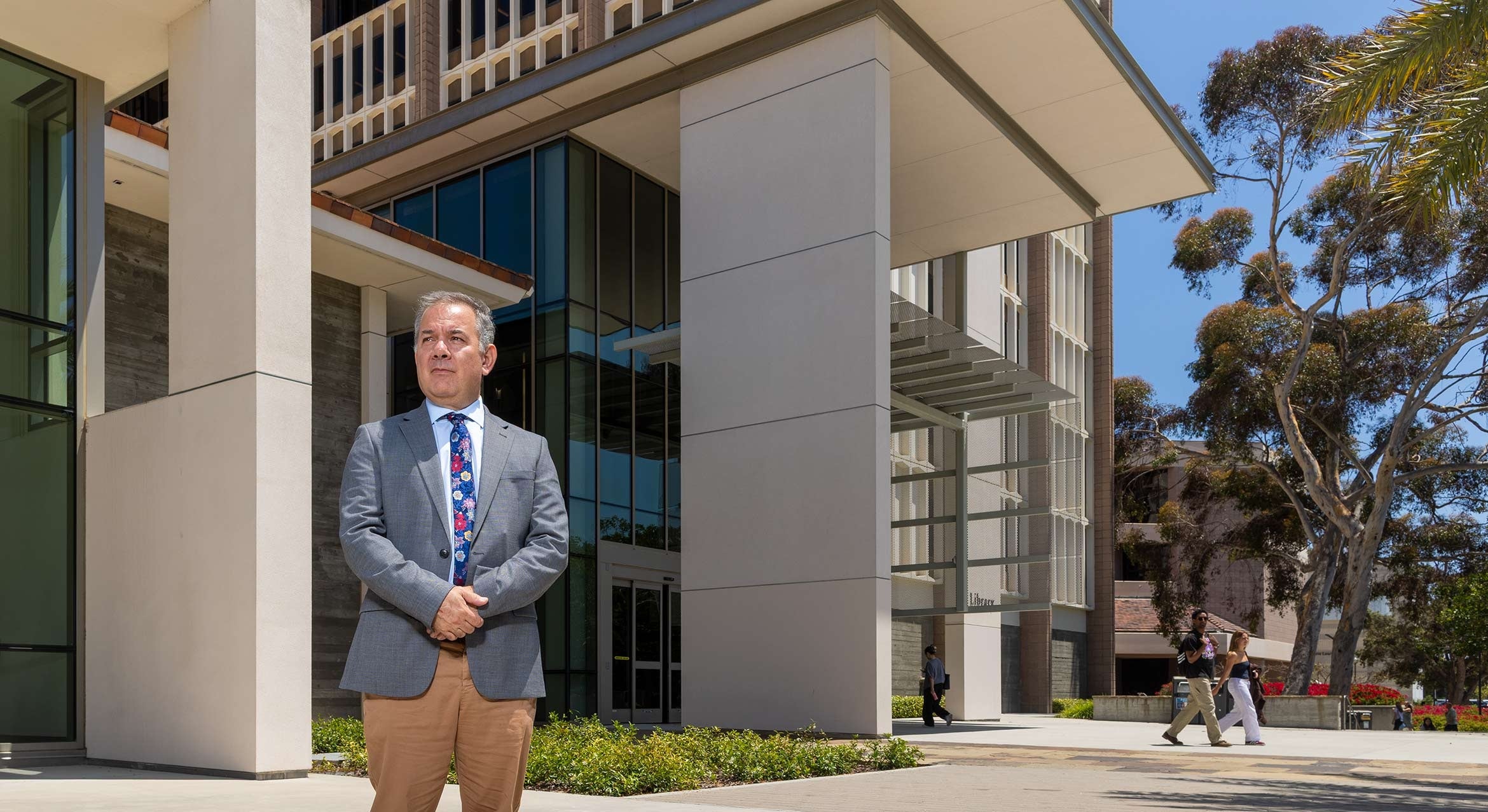Significant Impact
Each year hundreds of newly minted Ph.D. students graduate from UC Santa Barbara. Of that cohort, some already have made significant methodological and substantive contributions to their fields of study. Among these are students honored with the Winifred and Louis Lancaster Dissertation Awards.
“The completion of a doctoral dissertation is an event worth celebrating in and of itself,” said said Robert Hamm, assistant dean of the Graduate Division. “Beyond the personal achievement, a number of these projects will have significant impact on their respective areas of research.
The competition was tight for the 2020 Lancaster awards, as the Graduate Council reviewed dissertations from some of the brightest minds in mathematics, physical and life sciences, engineering and the social social sciences, all of whom are at the starting line of their research careers.
This year’s recipients are sociologist Annie Hikido and electrical engineer Junkai Jiang.
“The award is a great honor: A celebration of great work accomplished and a vote of confidence of even greater things to come,” said Hamm. “I’m delighted to congratulate the winners and nominees on their accomplishments. They represented the very best of graduate education.”
Reflections of Inequality
It’s been more than two decades since the official end of apartheid in South Africa, but inequalities between Black and white persist — the continuing effects of decades of entrenched white supremacy since the country’s colonization. The state increasingly promotes international tourism as a way to create some upward mobility, and spurred by the opportunity, some middle-aged and elderly Black South African women have turned their homes into bed-and-breakfasts in an endeavor to capture some of the global tourism market.
“I had a concern with South Africa’s racial domination and displacement by way of my Japanese-American family’s incarceration during World War II. When I started at UCSB, I learned that some Black South African women were hosting white tourists for overnight township stays,” said sociologist Annie Hikido. “That launched so many questions for me about whiteness, Blackness and emotional commodification through globalization.”
Indeed, what would go into the construction of an authentic South African guest experience for what would presumably be a clientele of white Westerners? It was an interesting lens through which to view white Western ideas, and it was the seed of Hikido’s dissertation, “The Black Township Hospitality Market: Intimacies, Authenticities and Postcolonial Imaginaries in South Africa.”
Hikido’s work has received critical acclaim on campus. Her advisor, France Winddance Twine, describes it as “field defining,” and Black studies emeritus professor George Lipsitz calls it “one of the finest dissertations I have supervised and helped mentor during my 15 years at UCSB and my 40 years teaching and advising at research universities across the nation” and feminist scholar Eileen Boris describes it as “gestur(ing) strongly at the 21st Century and its challenges.” The research builds a multidimensional picture of race, economy and culture via the interactions between Black township bed-and-breakfast hostesses, their clientele and their networks.
“I thought that South African tourism would make an illuminating site for examining white Western feelings and ideas about poor Black neighborhoods in the Global South,” Hikido said. Her initial assumption was that tourism would be driven almost exclusively by white Westerners with the money to spend and the desire for a “real” South African experience.
What she found was a far more nuanced situation.
“I had not expected to meet Black middle-class and local guests at all,” Hikido said. Once into her field work just outside Cape Town she found that the township hostesses accommodate a more diverse clientele and the experiences offered were tuned to the visitors’ race, class and nation. For the white Westerners, being surrounded by pan-African culture and décor is one demonstration of the authentic South Africa, while for Black South Africans with means, it is in aspirational opulence that signals the rising status of the country.
“The local Black South African sector was the most surprising to me, but made complete sense given their lack of adequate housing,” Hikido said of the market for whom the accommodations are typically spartan, and generally not advertised. “Most of the places that only served locals aren’t listed online or in official tourism materials because it’s a stigmatized market, since it facilitates extramarital relationships. It especially showed how many Black South Africans still do not have access to the wealth and comforts that have made South Africa a desirable tourist destination. So much so that they are willing to pay for an hour of privacy.”
The market as a whole, she said, illustrates the contradicting perspectives of post-apartheid South Africa and the failure of democracy in “democratic” states.
Now an assistant professor of sociology at Colby College in Maine, Hikido continues to maintain relationships with participants in her study and plans to write a book about this work. She advocates for turning the ethnographic gaze toward both advantaged and disadvantaged groups to more fully capture how systems of inequality work. “I’m grateful for the Lancaster award because it recognizes my work as much as my advisors, friends, research participants and family who supported it,” she said. “I hope it inspires other students to pursue long-term critical ethnographic projects and dialogue with their participants through the research process.”
Tomorrow’s Tech, Today
Ever since his high school days in China, Junkai Jiang has been fascinated by computers and their continuous evolution from power-guzzling room-sized behemoths to smaller, more efficient and sophisticated machines.
“Over the past five decades, computers have become more powerful, smaller and less power-hungry,” he said. “Computers have brought such enormous changes to our everyday lives that few other technologies have.”
Those advances were fueled primarily by miniaturizing components such as transistors and packing them more densely, improving performance without a proportional increase in the energy required, following the well-known axiom known as Moore’s Law — the observation that the number of transistors in a dense integrated circuit doubles about every two years.
But there’s a limit to how small and dense these components can become before physics takes over and they begin to interfere with each other, diminishing functionality. It’s a problem that manufacturers are already facing.
“During the last decade, the semiconductor industry has been confronting a significant problem in the domain of interconnects due to a sharp rise in the resistivity of copper wires as they were made narrower to meet scaling requirements,” Jiang said.
The need to overcome these types of physical limits is the driving force behind Jiang’s research, and his Lancaster Award-winning dissertation, “CMOS-Compatible Doped-Multilayer-Graphene for Next-Generation Interconnects, Passives, and Monolithic-3D Integrated Circuits.”
“It is a genuine technological breakthrough in the practical application of the novel material graphene to integrated circuit design and manufacture, which may very well be the foundation for the next generation of computer chips,” remarked Jiang’s advisor Kaustav Banerjee.
“One of the essential things in research is to find the right problem to solve,” Jiang said. For electrical engineers, finding designs that can meet increasing computer performance demands while maintaining energy efficiency — and in a mass manufacture-friendly fashion — is among the most worthy of challenges.
Enter graphene, a novel material with the potential to become to future electronics what silicon is today to our laptops and cellphones. Only one atom thick, with remarkable electronic properties, graphene has the profile and performance that could be harnessed and designed into a variety of structures, components and architectures.
“By talking to my advisor, who is a pioneer in 2D-based nanoelectronics, senior group members and fellow graduate students, I learned the state-of-the-art technologies and challenges,” Jiang said. He focused his research on exploring the feasibility of novel nanomaterials such as graphene and other 2D materials to bypass the performance degrading effects of tightly packed interconnects (the wires that carry signal from one component in a circuit to another). He also studied the potential for these atom-thick nanomaterials to be designed into ultra-high-density, yet ultimately thin 3D-stacked chips to extend Moore’s Law beyond the current roadmap. He presented at premier conferences to understand key challenges from the industry perspective. The result? According to Banerjee, work that was “already receiving wide recognition in the electronics industry.”
“I was absolutely thrilled to hear the news and particularly pleased to be the third Ph.D. student from our group to win the Lancaster Award,” said Jiang. Now a hardware designer at Google’s Sunnyvale campus, he’s designing chips to accelerate online services, and he looks forward to developing innovative solutions for high-performance, low power electronics using the skills he learned and refined during his time at UC Santa Barbara.
"Over all, I feel I could not have selected a better research group and advisor,” he said. “I was also very well supported by senior group members and department research staff.”




